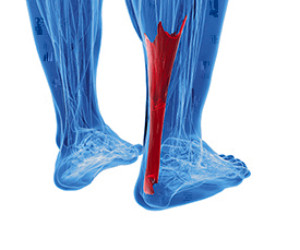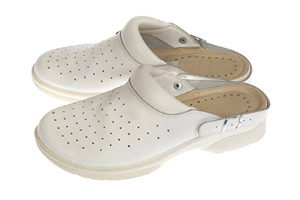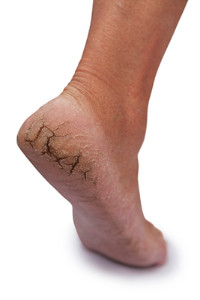

 When it comes to looking for a pair of walking shoes, there are many different options out there, and it could be easy to feel overwhelmed. Here are a couple of shoe features that you should be on the lookout for. A toe box that provides enough wiggle room for your toes is important. The shoes shouldn't be too tight or too loose. A good pair of shoes should conform to the shape of your foot. Knowing what type of arches you have can also help, as they will allow you to pick a pair that accommodates your foot type. Finally, walking shoes should be comfortable to wear. If a pair of shoes you want does not provide enough cushion, see if the insoles can be swapped out for more comfortable ones or custom-made orthotics. If you would like to know more about your foot type and which show would be best suited for you, a podiatrist can analyze your foot and provide you with personalized recommendations.
When it comes to looking for a pair of walking shoes, there are many different options out there, and it could be easy to feel overwhelmed. Here are a couple of shoe features that you should be on the lookout for. A toe box that provides enough wiggle room for your toes is important. The shoes shouldn't be too tight or too loose. A good pair of shoes should conform to the shape of your foot. Knowing what type of arches you have can also help, as they will allow you to pick a pair that accommodates your foot type. Finally, walking shoes should be comfortable to wear. If a pair of shoes you want does not provide enough cushion, see if the insoles can be swapped out for more comfortable ones or custom-made orthotics. If you would like to know more about your foot type and which show would be best suited for you, a podiatrist can analyze your foot and provide you with personalized recommendations.
Finding a properly-fitting shoe is important in reducing injuries and preventing foot problems. For more information about treatment, contact Dr. Sybil J. Fisher from Texas. Our doctor will treat your foot and ankle needs.
Proper Shoe Fitting
A common concern when it comes to foot health, having properly fitted shoes can help prevent injuries to the foot. Out feet affect our posture and gait, which in turn affects the biomechanics and overall bodily structure. With 33 joints, 26 bones, and over 100 ligaments, the potential for serious injury is much greater than one realizes. Although the feet cease growth in adulthood, they still change shape as they mature. Here are some factors to consider when it comes to investing in proper fitting shoes:
Keeping in mind how shoes fit the biomechanics of your body, properly-fitting shoes are vitally important. Fortunately, it is not difficult to acquire footwear that fits correctly. Be sure to wear shoes that support the overall structure of your body. Do your feet a favor and invest in several pairs of well-fitted shoes today.
If you have any questions please feel free to contact one of our offices located in Houston and Sugar Land, TX . We offer the newest diagnostic and treatment technologies for all your foot and ankle needs.
When it comes to maintaining foot health, wearing properly-fitting shoes is important. While wearing the appropriate pair of shoes may seem like a trivial concern, the reality is that improperly fitted shoes cause an astounding amount of injuries to the feet. The overall structure and the biomechanics of our bodies are directly affected by our posture, gait, and feet. Because of this, pain and discomfort felt throughout the body are often related to a problem in the feet. And, most foot problems usually stem from improper footwear.
Shoes should not be purchased with the expectation that they will easily stretch and contort to the size and shape of your feet. When shopping for footwear, look for shoes that fit correctly and comfortably as soon as you put them on. Do not purchase shoes that are too large or that slip in the heel area when you walk. Do not choose shoes that are loose with the intention of wearing thicker socks to compensate for the space. The widest portion of the shoe, the ball of the foot, must be made sure to fit comfortably in the shoe.
Keeping all of these suggestions in mind may be difficult when shopping and when trying to select from a wide array of different shoes. Nonetheless, your time and money will be wasted if you purchase a pair of shoes that are too uncomfortable for you to actually wear them. After finally selecting and purchasing a pair of shoes, try them on at home. To truly ensure whether or not your shoes fit comfortably with normal activity, walk around on a carpeted surface to determine how they feel on your feet.
The possibility of damaging your feet’s 33 joints, 26 bones, and 100+ ligaments is much higher than many people suspect. Finding an appropriate and properly-fitted pair of shoes is perhaps the single most important action you can take to maintain excellent foot health and help prevent injury. The fact that our feet continue to change with age is one that many people often forget. Even if our feet no longer change in size when we mature, our feet will still change in shape.
If you already have pre-existing foot problems, there is a greater possibility that wearing improperly-fitted shoes will worsen those problems. The good news, however, is that appropriate footwear is not difficult to find. While shopping for shoes, remember that improper footwear can detrimentally affect the feet, the entire body and its biomechanical structure as well. The shoes you wear can greatly impact your legs, back, and entire body, as your posture and gait are related to your feet. Finding and selecting the best properly-fitted shoes is necessary in achieving optimal health.
The plantar fascia is a connective tissue in the heel that stretches across the bottom length of your foot. Plantar fasciitis occurs when the connective tissue becomes inflamed, causing heel pain and discomfort during physical activity. Although the condition is completely treatable, traditional methods can take up to a year to start becoming effective.
Plantar fasciitis is caused by a number of everyday activities, so understanding the condition is important for managing and treating it. One of the most common causes of plantar fasciitis is excessive running, especially with improper fitting or non-supportive shoes. Too much exercise can lead to the plantar fascia being overworked and overstretched, which can cause tears in the tissue. Along with improper fitting shoes, pronation, the rolling of the feet inward, is a common cause of plantar fasciitis. If not treated properly, the plantar fascia becomes overstretched and starts to tear, causing inflammation.
Despite the common causes of plantar fasciitis, there are many different treatment options. For less severe cases, conservative home remedies include taking anti-inflammatory drugs to alleviate pain, applying ice packs to the bottom of your foot and heel, slowly stretching and exercising your feet to re-strengthen the tissue, and using orthotic devices are all ways to help manage your plantar fasciitis.
For more severe cases, shockwave therapy has become a common solution for plantar fasciitis. Shockwave therapy can effectively break up the tissue on the bottom of your foot which facilitates healing and regeneration. This fights the chronic pain caused by plantar fasciitis. Even if this doesn’t work, surgery is always a final option. Surgery on the tissue itself can be done to permanently correct the issue and stop the inflammation and pain in your heels.
No matter what the case may be, consulting your podiatrist is the first and best step to recovery. Even the slightest amount of heel pain could be the first stage of plantar fasciitis. Untreated symptoms can lead to the tearing and overstretching of tissue. Because the tearing of tissue can be compounded if it remains ignored, it can evolve into a severe case. The solution is early detection and early treatment. Talk to your podiatrist about the possibilities of plantar fasciitis if you’re experiencing heel pain.
 Gout, a form of arthritis caused by uric acid crystals forming in joints, can be very painful and can occur in any joint in the body. Thankfully, gout can be managed with a good diet. Avoiding high intakes of acid-rich food is advised. Purines, which are converted into uric acid by the body, come from animal and plant foods. Purine-rich diets, especially from meat and seafood, increase the risk of gout attacks. While not completely preventing gout attacks, diets with plenty of vegetables do help. Low-fat dairy products have been found to prevent uric acid buildup as well. Alcohol has also been linked with dramatically increased rates of gout attacks, so cutting back on alcohol is a great way to prevent gout attacks. While improving your diet won’t eliminate gout, it will certainly help to lessen attacks and their effects.
Gout, a form of arthritis caused by uric acid crystals forming in joints, can be very painful and can occur in any joint in the body. Thankfully, gout can be managed with a good diet. Avoiding high intakes of acid-rich food is advised. Purines, which are converted into uric acid by the body, come from animal and plant foods. Purine-rich diets, especially from meat and seafood, increase the risk of gout attacks. While not completely preventing gout attacks, diets with plenty of vegetables do help. Low-fat dairy products have been found to prevent uric acid buildup as well. Alcohol has also been linked with dramatically increased rates of gout attacks, so cutting back on alcohol is a great way to prevent gout attacks. While improving your diet won’t eliminate gout, it will certainly help to lessen attacks and their effects.
Gout is a foot condition that requires certain treatment and care. If you are seeking treatment, contact Dr. Sybil J. Fisher from Texas. Our doctor will treat your foot and ankle needs.
What Is Gout?
Gout is a type of arthritis caused by a buildup of uric acid in the bloodstream. It often develops in the foot, especially the big toe area, although it can manifest in other parts of the body as well. Gout can make walking and standing very painful and is especially common in diabetics and the obese.
People typically get gout because of a poor diet. Genetic predisposition is also a factor. The children of parents who have had gout frequently have a chance of developing it themselves.
Gout can easily be identified by redness and inflammation of the big toe and the surrounding areas of the foot. Other symptoms include extreme fatigue, joint pain, and running high fevers. Sometimes corticosteroid drugs can be prescribed to treat gout, but the best way to combat this disease is to get more exercise and eat a better diet.
If you have any questions please feel free to contact one of our offices located in Houston and Sugar Land, TX . We offer the newest diagnostic and treatment technologies for all your foot and ankle needs.
 The Achilles tendon, while the largest and thickest tendon in the body, is prone to being injured just like any body part. Tendinopathy, the breakdown of the tendon, generally occurs from overuse—especially from athletic activities. In some cases, the tendon can even rupture completely. While overuse directly causes the injury, there are other factors that increase the risk. These factors include bending the foot backwards, or dorsiflexion, weak calf muscles, and pronation. Compared to other muscle recoveries, tendons take longer to heal and can even take up to a year to fully recover. While anti-inflammatory medication may bring relief, it will not heal the injury. Ultimately, the best thing to do for an Achilles tendon injury is to see a podiatrist. Podiatrists offer the best treatment options and recovery programs for such injuries, and they can help patients heal properly so they can get back in the game.
The Achilles tendon, while the largest and thickest tendon in the body, is prone to being injured just like any body part. Tendinopathy, the breakdown of the tendon, generally occurs from overuse—especially from athletic activities. In some cases, the tendon can even rupture completely. While overuse directly causes the injury, there are other factors that increase the risk. These factors include bending the foot backwards, or dorsiflexion, weak calf muscles, and pronation. Compared to other muscle recoveries, tendons take longer to heal and can even take up to a year to fully recover. While anti-inflammatory medication may bring relief, it will not heal the injury. Ultimately, the best thing to do for an Achilles tendon injury is to see a podiatrist. Podiatrists offer the best treatment options and recovery programs for such injuries, and they can help patients heal properly so they can get back in the game.
Achilles tendon injuries need immediate attention to avoid future complications. If you have any concerns, contact Dr. Sybil J. Fisher of Texas. Our doctor can provide the care you need to keep you pain-free and on your feet.
What Is the Achilles Tendon?
The Achilles tendon is a tendon that connects the lower leg muscles and calf to the heel of the foot. It is the strongest tendon in the human body and is essential for making movement possible. Because this tendon is such an integral part of the body, any injuries to it can create immense difficulties and should immediately be presented to a doctor.
What Are the Symptoms of an Achilles Tendon Injury?
There are various types of injuries that can affect the Achilles tendon. The two most common injuries are Achilles tendinitis and ruptures of the tendon.
Achilles Tendinitis Symptoms
Rupture Symptoms
Treatment and Prevention
Achilles tendon injuries are diagnosed by a thorough physical evaluation, which can include an MRI. Treatment involves rest, physical therapy, and in some cases, surgery. However, various preventative measures can be taken to avoid these injuries, such as:
If you have any questions please feel free to contact one of our offices located in Houston and Sugar Land, TX . We offer the newest diagnostic tools and technology to treat your foot and ankle needs.
 Choosing the right pair of shoes is essential for children. This is due to the fact that children’s feet are still developing, so shoes that aren’t of good quality or fit can potentially create foot problems. When shopping for shoes for your children, make sure they fit properly and that they are durable as well. Rubber soles are recommended to provide good grip and prevent falls. Ensure that the toe-box provides enough wiggle room for their toes and that shoes are made of breathable materials like leather or mesh. Shoes should be stiff where the sole thickens, but flexible where the toes are. It may be tempting to buy shoes that are bigger so that their feet will grow into them, but this could lead to tripping and potential injury. Every child is different, so taking your child to get properly fitted is always recommended.
Choosing the right pair of shoes is essential for children. This is due to the fact that children’s feet are still developing, so shoes that aren’t of good quality or fit can potentially create foot problems. When shopping for shoes for your children, make sure they fit properly and that they are durable as well. Rubber soles are recommended to provide good grip and prevent falls. Ensure that the toe-box provides enough wiggle room for their toes and that shoes are made of breathable materials like leather or mesh. Shoes should be stiff where the sole thickens, but flexible where the toes are. It may be tempting to buy shoes that are bigger so that their feet will grow into them, but this could lead to tripping and potential injury. Every child is different, so taking your child to get properly fitted is always recommended.
Making sure that your children maintain good foot health is very important as they grow. If you have any questions, contact Dr. Sybil J. Fisher of Texas. Our doctor can provide the care you need to keep you pain-free and on your feet.
Keeping Children's Feet Healthy
Having healthy feet during childhood can help prevent medical problems later in life, namely in the back and legs. As children grow, their feet require different types of care. Here are some things to consider...
Although babies do not walk yet, it is still very important to take care of their feet.
Avoid putting tight shoes or socks on his or her feet.
Allow the baby to stretch and kick his or her feet to feel comfortable.
As a toddler, kids are now on the move and begin to develop differently. At this age, toddlers are getting a feel for walking, so don’t be alarmed if your toddler is unsteady or ‘walks funny’.
As your child gets older, it is important to teach them how to take care of their feet.
Show them proper hygiene to prevent infections such as fungus.
Be watchful for any pain or injury.
Have all injuries checked by a doctor as soon as possible.
Comfortable, protective shoes should always be worn, especially at play.
If you have any questions please feel free to contact one of our offices located in Houston and Sugar Land, TX . We offer the newest diagnostic and treatment technologies for all your foot and ankle needs.
 Diabetics are at an increased risk for serious foot injuries. Due to neuropathy, or nerve loss, diabetics may not realize that they have foot wounds. They also generally experience poor blood circulation; this means it’s harder for wounds to heal and makes infection more likely. Seeing a podiatrist before going shoe shopping is a great idea for diabetics, as he or she can also make custom recommendations. When you do go shopping, going later in the day is best as feet get larger throughout the day. If one foot is larger than the other, go with a size that provides enough space for the larger foot. A good pair of shoes should be soft and provide ample cushion and enough support. Make sure that there aren’t any seams in the shoes that can rub up against your feet, and ensure that the shoes provide space for the toes to wiggle. Finally, replace your shoes when they become worn out. Diabetes brings many challenges with it, but knowing how to take care of your feet can prevent potential harm.
Diabetics are at an increased risk for serious foot injuries. Due to neuropathy, or nerve loss, diabetics may not realize that they have foot wounds. They also generally experience poor blood circulation; this means it’s harder for wounds to heal and makes infection more likely. Seeing a podiatrist before going shoe shopping is a great idea for diabetics, as he or she can also make custom recommendations. When you do go shopping, going later in the day is best as feet get larger throughout the day. If one foot is larger than the other, go with a size that provides enough space for the larger foot. A good pair of shoes should be soft and provide ample cushion and enough support. Make sure that there aren’t any seams in the shoes that can rub up against your feet, and ensure that the shoes provide space for the toes to wiggle. Finally, replace your shoes when they become worn out. Diabetes brings many challenges with it, but knowing how to take care of your feet can prevent potential harm.
Diabetic foot care is important in preventing foot ailments such as ulcers. If you are suffering from diabetes or have any other concerns about your feet, contact Dr. Sybil J. Fisher from Texas. Our doctor can provide the care you need to keep you pain-free and on your feet.
Diabetic Foot Care
Diabetes affects millions of people every year. The condition can damage blood vessels in many parts of the body, especially the feet. Because of this, taking care of your feet is essential if you have diabetes, and having a podiatrist help monitor your foot health is highly recommended.
The Importance of Caring for Your Feet
Patients with diabetes should have their doctor monitor their blood levels, as blood sugar levels play such a huge role in diabetic care. Monitoring these levels on a regular basis is highly advised.
It is always best to inform your healthcare professional of any concerns you may have regarding your feet, especially for diabetic patients. Early treatment and routine foot examinations are keys to maintaining proper health, especially because severe complications can arise if proper treatment is not applied.
If you have any questions please feel free to contact one of our offices located in Houston and Sugar Land, TX . We offer the newest diagnostic and treatment technologies for all your foot and ankle needs.
 For those who stand most of the day while working, foot pain is common. However, there are things you can do to alleviate pain. The type of shoes you wear have a big impact on their wearability. Shoes should have enough space so that toes can move freely. Shoes like open-back heels and sandals are not very supportive and can be bad for feet. Women should also avoid high heels. Shoes should also support the arch, and if not, podiatrists offer custom-made orthotics. Athletic shoes generally offer more support and are a good choice. Stretching your feet can help deal with pain, as can soaking them in a tub. Wearing clean, dry socks can prevent athlete’s foot; foot powder can as well, while also keeping them dry. While you may have to stand all day while you work, this doesn’t mean you have to experience discomfort.
For those who stand most of the day while working, foot pain is common. However, there are things you can do to alleviate pain. The type of shoes you wear have a big impact on their wearability. Shoes should have enough space so that toes can move freely. Shoes like open-back heels and sandals are not very supportive and can be bad for feet. Women should also avoid high heels. Shoes should also support the arch, and if not, podiatrists offer custom-made orthotics. Athletic shoes generally offer more support and are a good choice. Stretching your feet can help deal with pain, as can soaking them in a tub. Wearing clean, dry socks can prevent athlete’s foot; foot powder can as well, while also keeping them dry. While you may have to stand all day while you work, this doesn’t mean you have to experience discomfort.
While working on the feet, it is important to take the proper care of them. For more information about working on your feet, contact Dr. Sybil J. Fisher from Texas. Our doctor will treat your foot and ankle needs.
Working on Your Feet
Standing on your feet for long periods of time can cause stress and pain in your feet. Your whole body may experience change in terms of posture, back pain, bunions, callouses and or plantar warts. There are ways to avoid these conditions with proper foot care, smart choices and correct posture.
Positive Changes
Negative heeled shoe – Choosing this shoe type places the heel slightly lower than the ball of the foot. These are great for overall foot health. Find shoes that fit you correctly.
Go barefoot – Our feet were not designed to be enclosed for all hours of the day. Try to periodically expose your feet to air.
Eliminate Pain
Foot Exercises – Performing simple exercises, incorporating yoga and doing stretches are beneficial. This will allow increased blood flow to the area and muscles of the foot.
Achilles tendon – Stretching the foot out flat on the floor will relax the calf muscles and tendon. These exercises can be performed almost anywhere. Make sure you add these exercises to your daily regimen.
With a little bit of this information and knowing more about foot health, you will notice changes. Foot stretches and proper footwear will help with pain and prevent further issues.
If you have any questions please feel free to contact one of our offices located in Houston and Sugar Land, TX . We offer the newest diagnostic and treatment technologies for all your foot and ankle needs.
 Women’s feet have increased two sizes since the 1970s, and yet their shoe sizes haven’t. Women who have larger feet are, unfortunately, left out and have few options. Some girls have resorted to wearing boys’ shoes, which are not properly fitted for women; this can lead to an increase risk of falling and other issues. Several experts blame this on overseas production and it not being cost-effective to make bigger shoes. Bigger shoes cost more to make; however, they are accounting for larger percentages in the footwear market. A few experts recommend buying from German companies, who have kept up with foot size increases. It is important that not only women, but also men, wear properly fitted shoes. Shoes that are too small can lead to issues like plantar fasciitis, corns, hammertoes, and a number of ailments that cause foot pain.
Women’s feet have increased two sizes since the 1970s, and yet their shoe sizes haven’t. Women who have larger feet are, unfortunately, left out and have few options. Some girls have resorted to wearing boys’ shoes, which are not properly fitted for women; this can lead to an increase risk of falling and other issues. Several experts blame this on overseas production and it not being cost-effective to make bigger shoes. Bigger shoes cost more to make; however, they are accounting for larger percentages in the footwear market. A few experts recommend buying from German companies, who have kept up with foot size increases. It is important that not only women, but also men, wear properly fitted shoes. Shoes that are too small can lead to issues like plantar fasciitis, corns, hammertoes, and a number of ailments that cause foot pain.
Getting the right shoe size is an important part of proper foot health. Seek the assistance of Dr. Sybil J. Fisher from Texas. Our doctor will provide the care you need to keep you pain-free and on your feet.
Getting the Right Shoe Size
There are many people who wear shoes that are the incorrect size, negatively affecting their feet and posture. Selecting the right shoes is not a difficult process, so long as you keep several things in mind when it comes to choosing the right pair.
As our feet hold our body weight and keep us moving, it is important to treat them right. Picking the right pair of shoes can provide your feet comfort and mobility without pain.
If you have any questions, please feel free to contact one of our offices located in Houston and Sugar Land, TX . We offer the newest diagnostic and treatment technologies for all your foot care needs.
 While cracked heels affect people of all ages, they tend to be more prevalent in women compared to men. Nevertheless, cracked heels are much more likely to develop in those who stand for long periods of time, or wear backless shoes that don’t cover the heel. If you are suffering from dry, cracked heels; you should try to soak and exfoliate them routinely. This should be done using a pumice stone or loofah as these are both very effective in removing dry skin. Another tip is to moisturize your feet and cover them overnight using socks.
While cracked heels affect people of all ages, they tend to be more prevalent in women compared to men. Nevertheless, cracked heels are much more likely to develop in those who stand for long periods of time, or wear backless shoes that don’t cover the heel. If you are suffering from dry, cracked heels; you should try to soak and exfoliate them routinely. This should be done using a pumice stone or loofah as these are both very effective in removing dry skin. Another tip is to moisturize your feet and cover them overnight using socks.
Cracked heels are unsightly and can cause further damage to your shoes and feet. If you have any concerns, contact Dr. Sybil J. Fisher from Texas. Our doctor can provide the care you need to keep you pain-free and on your feet.
Cracked Heels
Cracked heels appear unappealing and can make it harder for you walk around in sandals. Aside from looking unpleasant, cracked heels can also tear stockings, socks, and wear out your shoes. There are several methods to help restore a cracked heel and prevent further damage.
How Do You Get Them?
Dry skin is the number one culprit in creating cracked heels. Many athletes, walkers, joggers, and even swimmers suffer from cracked heels. Age and skin oil production play a role to getting cracked heels as well.
Promote Healing
Over the counter medicines can help, especially for those that need instant relief or who suffer from chronic dry feet.
Wear Socks – Wearing socks with medicated creams helps lock in moisture.
Moisturizers – Applying both day and night will help alleviate dryness which causes cracking.
Pumice Stones – These exfoliate and remove dead skin, which allows for smoother moisturizer application and better absorption into the skin.
Change in Diet
Eating healthy with a well-balanced diet will give the skin a fresh and radiant look. Your body responds to the kinds of food you ingest. Omega-3 fatty acids and zinc supplements can also revitalize skin tissue.
Most importantly, seek professional help if unsure how to proceed in treating cracked heels. A podiatrist will help you with any questions or information needed.
If you have any questions, please feel free to contact one of our offices located in Houston and Sugar Land, TX . We offer the newest diagnostic and treatment technologies for all your foot care needs.
Copyright © 2016 S.J. Fisher DPM | Site Map | Design by: Podiatry Content Connection